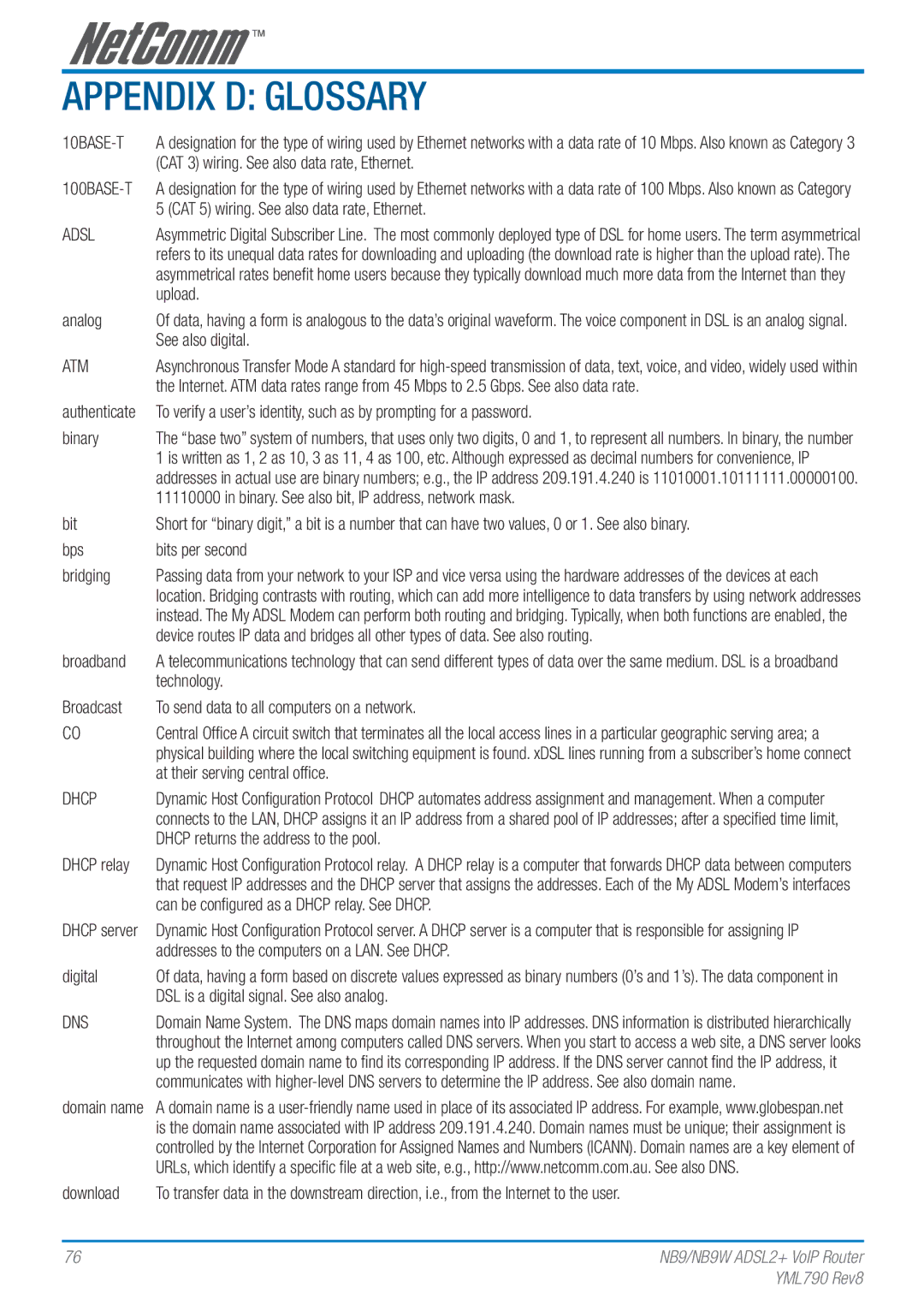Appendix D: Glossary
| A designation for the type of wiring used by Ethernet networks with a data rate of 10 Mbps. Also known as Category 3 |
| (CAT 3) wiring. See also data rate, Ethernet. |
| A designation for the type of wiring used by Ethernet networks with a data rate of 100 Mbps. Also known as Category |
| 5 (CAT 5) wiring. See also data rate, Ethernet. |
ADSL | Asymmetric Digital Subscriber Line. The most commonly deployed type of DSL for home users. The term asymmetrical |
| refers to its unequal data rates for downloading and uploading (the download rate is higher than the upload rate). The |
| asymmetrical rates benefit home users because they typically download much more data from the Internet than they |
| upload. |
analog | Of data, having a form is analogous to the data’s original waveform. The voice component in DSL is an analog signal. |
| See also digital. |
ATM | Asynchronous Transfer Mode A standard for |
| the Internet. ATM data rates range from 45 Mbps to 2.5 Gbps. See also data rate. |
authenticate | To verify a user’s identity, such as by prompting for a password. |
binary | The “base two” system of numbers, that uses only two digits, 0 and 1, to represent all numbers. In binary, the number |
| 1 is written as 1, 2 as 10, 3 as 11, 4 as 100, etc. Although expressed as decimal numbers for convenience, IP |
| addresses in actual use are binary numbers; e.g., the IP address 209.191.4.240 is 11010001.10111111.00000100. |
| 11110000 in binary. See also bit, IP address, network mask. |
bit | Short for “binary digit,” a bit is a number that can have two values, 0 or 1. See also binary. |
bps | bits per second |
bridging | Passing data from your network to your ISP and vice versa using the hardware addresses of the devices at each |
| location. Bridging contrasts with routing, which can add more intelligence to data transfers by using network addresses |
| instead. The My ADSL Modem can perform both routing and bridging. Typically, when both functions are enabled, the |
| device routes IP data and bridges all other types of data. See also routing. |
broadband | A telecommunications technology that can send different types of data over the same medium. DSL is a broadband |
| technology. |
Broadcast | To send data to all computers on a network. |
CO | Central Office A circuit switch that terminates all the local access lines in a particular geographic serving area; a |
| physical building where the local switching equipment is found. xDSL lines running from a subscriber’s home connect |
| at their serving central office. |
DHCP | Dynamic Host Configuration Protocol DHCP automates address assignment and management. When a computer |
| connects to the LAN, DHCP assigns it an IP address from a shared pool of IP addresses; after a specified time limit, |
| DHCP returns the address to the pool. |
DHCP relay | Dynamic Host Configuration Protocol relay. A DHCP relay is a computer that forwards DHCP data between computers |
| that request IP addresses and the DHCP server that assigns the addresses. Each of the My ADSL Modem’s interfaces |
| can be configured as a DHCP relay. See DHCP. |
DHCP server | Dynamic Host Configuration Protocol server. A DHCP server is a computer that is responsible for assigning IP |
| addresses to the computers on a LAN. See DHCP. |
digital | Of data, having a form based on discrete values expressed as binary numbers (0’s and 1’s). The data component in |
| DSL is a digital signal. See also analog. |
DNS | Domain Name System. The DNS maps domain names into IP addresses. DNS information is distributed hierarchically |
| throughout the Internet among computers called DNS servers. When you start to access a web site, a DNS server looks |
| up the requested domain name to find its corresponding IP address. If the DNS server cannot find the IP address, it |
| communicates with |
domain name | A domain name is a |
| is the domain name associated with IP address 209.191.4.240. Domain names must be unique; their assignment is |
| controlled by the Internet Corporation for Assigned Names and Numbers (ICANN). Domain names are a key element of |
| URLs, which identify a specific file at a web site, e.g., http://www.netcomm.com.au. See also DNS. |
download | To transfer data in the downstream direction, i.e., from the Internet to the user. |
|
|
76 | NB9/NB9W ADSL2+ VoIP Router |
YML790 Rev8
